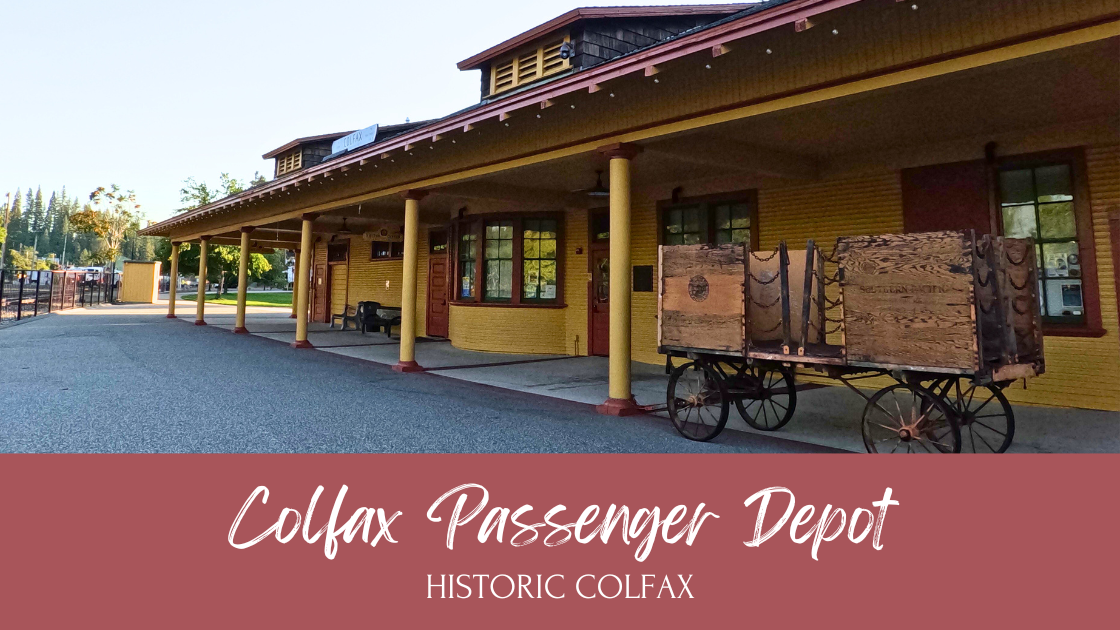Colfax Passenger Depot

In the heart of Colfax, CA, stands one of the town’s most significant historical landmarks—the Colfax Passenger Depot. Once a bustling hub of activity during the railroad’s heyday, the depot is more than just a train station; it’s a symbol of the town’s development and a testament to the crucial role the railroad played in shaping Colfax’s history. Today, the Colfax Passenger Depot stands as a preserved reminder of a bygone era, still serving travelers and visitors alike while reflecting the rich legacy of the town’s past.
The Early Days: A Railroad Boomtown
The story of the Colfax Passenger Depot begins in the 1860s, during the construction of the Central Pacific Railroad. The transcontinental railroad was one of the most ambitious projects of the 19th century, connecting the eastern United States with the Pacific Coast. As the railroad extended its reach through the rugged Sierra Nevada mountains, Colfax—then known as Illinoistown—became a vital stop along the route.
In 1865, the town was renamed Colfax in honor of Schuyler Colfax, the U.S. Vice President at the time, who played a significant role in supporting the railroad’s expansion. As the railroad reached Colfax, the town flourished, quickly transforming into a key hub for freight, passengers, and goods traveling between the Sacramento Valley and the high Sierra.
Construction of the Colfax Passenger Depot
The Colfax Passenger Depot was built in 1905 by the Southern Pacific Railroad, replacing an earlier depot that had served the town since the railroad’s arrival. The new depot was constructed in the architectural style typical of early 20th-century railway stations, featuring a simple yet elegant design that blended functionality with a welcoming aesthetic. It became a central point for travelers heading to and from the mountains, with trains stopping for passengers, mail, and freight.
During this period, the depot was a lively place, bustling with activity as residents and visitors alike made their way through Colfax. The station’s proximity to local hotels, such as the nearby Colfax Hotel, ensured that the town became a popular rest stop for tourists heading to the gold fields, the Sierra Nevada, or beyond.
The Role of the Depot in Colfax’s Growth
The Colfax Passenger Depot wasn’t just a transit point—it was the heartbeat of the town. The depot played a vital role in the local economy, bringing workers, travelers, and goods into Colfax. For residents, the train station was a connection to the wider world, allowing them to send and receive mail, supplies, and news. It was also a place where families and friends would gather to send off loved ones or greet them upon their return.
The railroad’s impact on Colfax extended beyond transportation; it shaped the town’s layout and economy. Businesses and homes were built near the depot, creating a bustling commercial district that thrived thanks to the constant flow of people and goods. The depot also helped sustain the town through the challenges of the early 20th century, including the Great Depression and World War II.
Decline and Preservation
By the mid-20th century, with the rise of automobile travel and the decline of railroads as the primary mode of transportation, the Colfax Passenger Depot, like many other train stations across the country, saw a reduction in passenger traffic. While freight services continued, the number of trains stopping in Colfax for passengers dwindled, and the depot’s once-busy platforms became quieter.
However, the depot’s historical significance was not forgotten. Recognizing its importance to the town’s heritage, local preservation efforts began in the late 20th century. In 1975, the Colfax Passenger Depot was added to the National Register of Historic Places, ensuring that the building would be protected and preserved for future generations.
The Depot Today: A Living Piece of History
Today, the Colfax Passenger Depot remains a vital part of the town, though its role has evolved. Amtrak continues to operate the California Zephyr route, stopping at Colfax for passengers traveling between the San Francisco Bay Area and Chicago. The depot also serves as a visitor center, where tourists can learn about the town’s rich history and its connection to the transcontinental railroad.
The building has been beautifully restored, with much of its original architecture and charm still intact. Visitors can explore the depot’s interior, view exhibits about Colfax’s railroad history, and even take a moment to imagine what life was like during the height of the railroad era. The surrounding area, including the historic rail tracks, adds to the authentic atmosphere of the site.
Local events and community gatherings are also held at the depot, making it a social and cultural hub once again, much like it was over a century ago. The depot stands as a proud symbol of Colfax’s connection to the larger history of California and the American West.
A Gateway to the Past and the Future
The Colfax Passenger Depot is more than just a relic of the past—it’s a testament to the enduring spirit of Colfax and the railroad that built it. As one of the few remaining depots along the original Central Pacific Railroad line, it offers visitors a glimpse into a time when trains were the lifeblood of the American frontier.
Whether you’re a history enthusiast, a railfan, or simply passing through on your way to the Sierra Nevada, a visit to the Colfax Passenger Depot is a must. It’s a reminder of how transportation shaped not just Colfax but the entire nation, connecting people, goods, and ideas in ways that still resonate today.
Contact
- 99 Railroad St, Colfax, CA 95713
